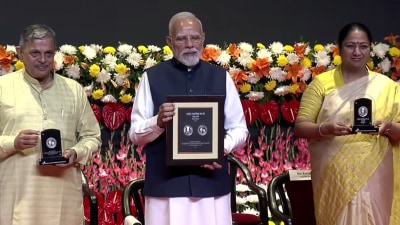Putting the invisible warriors together
At 4,800 tonnes and with exhaust from engines generating 500 times your car’s horsepower, this hulk is an odd candidate for unobtrusive...

At 4,800 tonnes and with exhaust from engines generating 500 times your car’s horsepower, this hulk is an odd candidate for unobtrusiveness.
Still, that is precisely the frigate Sahyadri’s distinguishing trait. She’s a warship that can creep up, hushed, on an enemy submarine, release an accurately-aimed torpedo and turn tail at a zippy 30 knots—the Sahyadri is a stealth warship.
And catching up with the elite club of US, French, Swedish and Russian navies’ stealth researchers are the 6,000-odd riggers, welders, electricians and engineers who’re building the Sahyadri and her sisters Shivalik and Satpura docked in the nearby wet basin at the Mazagon Dock Ltd, a 200-year-old shipbuilding yard at Mumbai’s Dockyard Road.
So, can India’s largest defence shipyard render a 143-metre ship invisible and soundless?
Not yet, but under P17—Project 17, okayed by the government in 1997 and production on since 2001—the Shivalik class will be the first indigenously conceptualised and executed stealth fleet of the Indian Navy.
‘‘We are minimising the various signatures of these ships,’’ says Vice Admiral SKK Krishnan, chairman and managing director of Mazagon Dock Ltd, a public sector undertaking under the administrative control of the Department of Defence Production of the Ministry of Defence.
So, while they’re no Swedish Visby or French Lafayette, the Shivalik class frigates will be a smaller, much more indistinct—for some time, invisible—blip on an enemy radar thanks to special radar-absorbent coats. Also, starting 7 am every day, teams of welders work on executing design alterations without compromising the smooth edges. Alert CISF jawans won’t allow visitors inside, but missile-launching systems are fully retractable—smooth edges means lower radar reflectivity. ‘‘The enemy now has to be a good deal closer to pick you up on his radar,’’ Krishnan explains affably. ‘‘That’s the advantage zone, since you can strike before being spotted.’’
Teams of engineers chalked out detailed working drawings based on designs prepared by the Naval Design Bureau with Russian collaboration—the Russians delivered three stealth warships of the Talwar class in 2002-04—using the Tribon software, which allows 2D drawings to be used as backdrop references for modelling 3D steel structures, placing of equipment, routing of pipes etc.
|
|
|
2009
Will lift India into an elite club of stealth-warship producing nations: US, UK, Sweden, France and Russia |
|
|
By the time the ships are ready, noise and vibration-proof mounts for gearboxes and other machinery will soak up acoustic signatures, electric coils running through the interior will reduce magnetic signature of the steel hull by creating an opposite magnetic field. Thermal signature will be significantly reduced through infrared suppression tools, exhaust-cooling and specially designed funnels.
Supervising the work is a Warship Production Superintendent, a Commodore-level officer from the Navy, based in Mazagon Dock for two years now with 15 to 20 officers in the warship overseeing team he heads.
Field Officer Commanding-in-Chief of the Western Naval Command Vice Admiral Madanjit Singh calls it a huge technological challenge, one that presents itself to every Naval employee as he learns to operate the newfangled equipment. ‘‘But the most important thing is the reduced number of people you require to operate such a ship—25 to 30 per cent less, since everything is automated.’’
With neighbours having recorded signals of practically every Indian ship (Krishnan says enemies can conduct a vibration analysis of a ship and through an elimination procedure, say with reasonable accuracy, that a particular ship is, say, the INS Talwar) stealth provides an advantage, however small.The ships are fitted with a mix of Indian, Russian and Western weaponry systems—surface-to-air missiles, surface-to-surface missiles, torpedoes, anti-submarine rockets, anti-aircraft guns, sonars and radars.
‘‘These are warships that will be serving for the next 30 years after they’re launched,’’ says Singh. ‘‘So they’re designed to incorporate midlife upgrades.’’ He adds that the Navy hopes to build at least six to eight ships of this class and since costs have risen, each year’s delay is a further setback.
But as methods of warfare mutate, from his vantage point at the helm of a revolution, the foremost significance for Krishnan is actually the ancillary industry the Made-in-India tag generates. ‘‘The thumbrule is that for every car on the roads, six persons get employment,’’ he says. ‘‘So for every warship in the sea, that number must be thousands.’’ From bathroom tiles to kitchen utensils, from carpenters to suppliers of radar equipment, crores are plowed back into the economy. Perhaps that is the Indian Navy’s most trendy gadgets’ best gift.
|
Sail to stealth club begins
|
||||
|
• The P-17, India’s most prestigious naval project for now, is an order for three indigenous stealth frigates, at a total cost of over Rs 3,000 crore. |
||||
FULL COVERAGE: FUTURE REPUBLIC



- 01
- 02
- 03
- 04
- 05




























